
SEAGULL -- BEFORE MINOLTA

Here is what we have in a somewhat chronological order, but it is mixed up with the model
numbers -- which are not always in the same order as the chronological order. Finally, a few of the models
listed here are based on photos and specifications from the Seagull website, but there is no evidence that these
models ever were manufactured, marketed, and sold. In fact, there is more evidence that they never made it
to actual production -- they might have simply been planned models, but still they are listed here just the same.
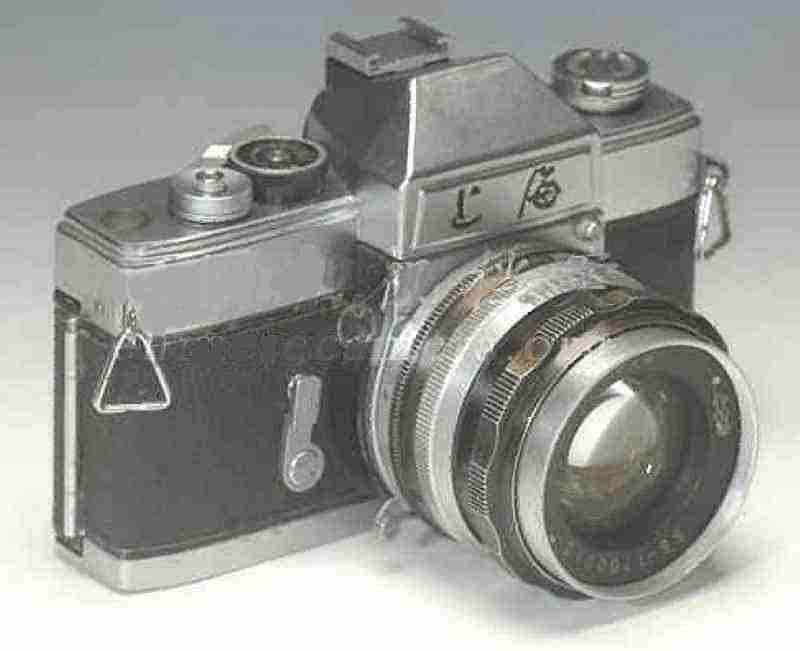
(1964) The prototype of Seagull's first SLR camera didn't yet have a name and the earliest pictures of this camera, which only has two Chinese characters on the body -- which mean "Shang Hai" (where the factory was located) -- shows a Minolta-style lens release button. Everything else indicates that this un-named SLR was based on the Minolta SR-2 of 1957. Many would claim it's a copy, but it isn't -- well, not exactly.
There are many myths and misunderstanding about this camera. First, it is often listed, in print and on the Internet, as a Chinese copy of the Minolta SRT-101 of 1966. But since it was on the drawing board well BEFORE the SRT-101 hit the market, this idea is obviously based on pure ignorance. In reality, the Seagull DF was more like a variant of the earlier Minolta SR-2 camera. Superficially, the Seagull looks much like the SRT-101, but internally it is substantially different. Although it has some similarities with the SRT-101 such as shutter speeds from 1 - 1/1000, plus B, cold flash shoe and a mirror lockup, it is a strictly manual exposure camera. It does not have a meter -- like the SRT-101. Plus, unlike the SRT-101, it has a round viewfinder -- much like the earliest Minolta SR cameras, not to mention a plain screen for viewing -- no microprism like the SRT-101. In addition, it has both FP and X connections for flash, and it even has a connection on the bottom for a motor drive -- on the same end as the film rewind button. The Minolta SRT-101 never had that:
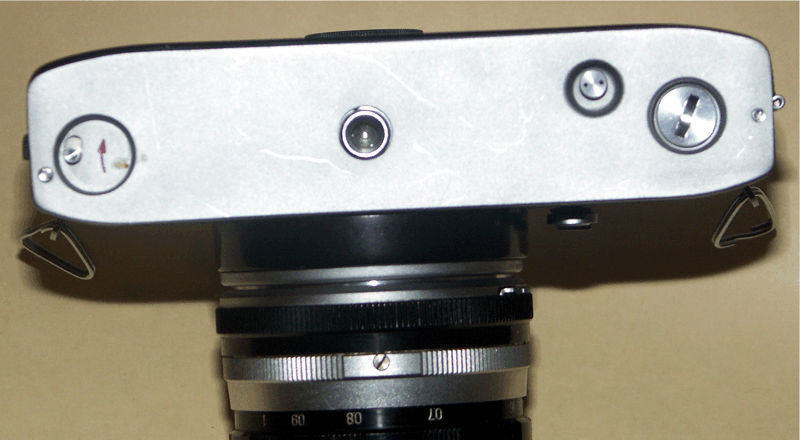
This may sound odd, but since the design for this camera was copied from the first Minolta SR cameras (which originally had a motor drive connection) it makes sense. Perhaps this explains the mirror lockup as well, which was never used by any Seagull lenses. Perhaps they just copied Minolta features directly, without regard to utility. Here is the Minolta SR-2, for comparison. You'll see a lot of similarities, but plenty of differences:
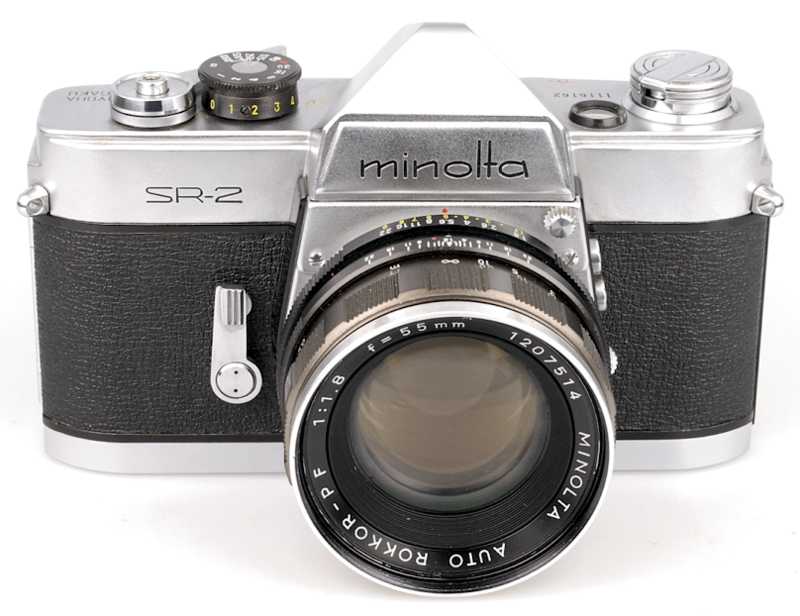
In the end, Seagull created a variant of the early Minolta SLR cameras -- not a copy. This
is easy to determine. The pentaprism on the first Seagull DF cameras is much larger than any of the early
Minolta cameras. Another example of the differences is the film door opening mechanism. On the early
Minolta cameras, the film rewind knob is pulled up and the film door pops open. This won't happen with the
early Seagull DF cameras. There is a special tab on the bottom to open the door. First it is pushed
to the rear -- in the direction of the imprinted arrow. Then it is depressed. This is pretty awkward,
and completely different from any Minolta SLR. There are many other differences between the Seagull DF and
Minolta cameras, so they are not simply copies. The DF had a cold shoe, the SR-2 did not. The film counter window
is on the opposite side of the camera...See for yourself

Probably in 1966 or 1967, a prototype appeared with the Seagull name, and the earliest pictures of this camera has two Chinese characters on the prism -- which mean "Sea Gull" and "Seagull" underneath in English
While it's easy to assume that some changes were made internall, the noticeable difference is the lack of
the ridge around the top plate of the camera -- which re-appears in the actual market models. What's interesting
is the addition of an MC tab on the lens -- indicating that this model appeared after the Minolta SRT 101.
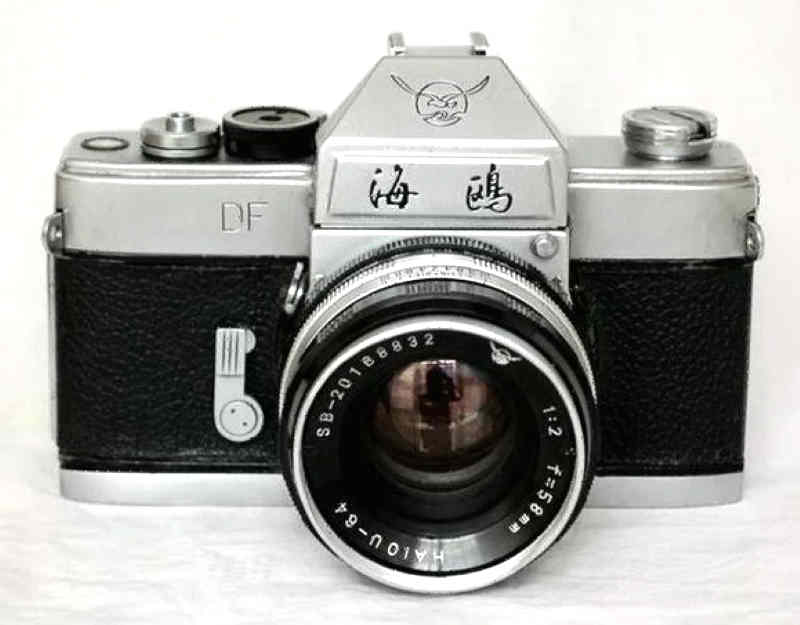
At some point around 1967, Seagull decided to give the camera a "name" -- of sorts. The
Shanghai General Camera Factory (AKA, Seagull) always assigned a "type" number to each of its camera
groups, such as "58" for its Leica derivatives, "4" for its 6X6 twin-lens reflexes, etc. For
this new 35mm SLR camera, Seagull decided to name it ![]() , which sounds like "Danfan" in PinYin (Romanized Chinese) --
or for short "DF"-- which, translated into English, means "SLR". So Seagull's
FIRST SLR camera is simply inscribed "DF" -- with the addition of a seagull on the top of the pentaprism
and two Chinese characters on the front meaning "Sea Gull". Is it doubtful that any of these first
cameras were actually marketed, so if you should find one, you will be rich!
, which sounds like "Danfan" in PinYin (Romanized Chinese) --
or for short "DF"-- which, translated into English, means "SLR". So Seagull's
FIRST SLR camera is simply inscribed "DF" -- with the addition of a seagull on the top of the pentaprism
and two Chinese characters on the front meaning "Sea Gull". Is it doubtful that any of these first
cameras were actually marketed, so if you should find one, you will be rich!
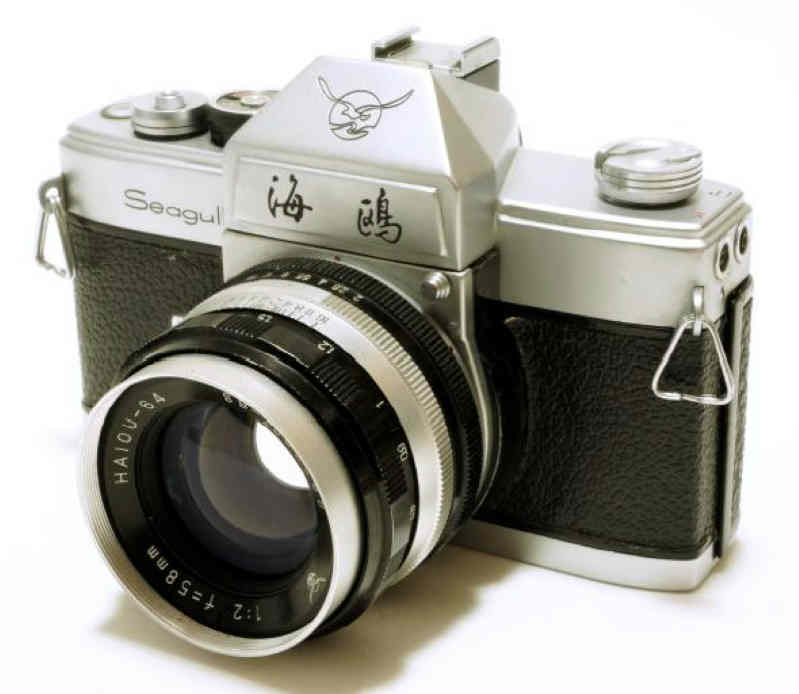
The first Seagull SLR that made it to the streets -- around 1968 -- lost the "DF" designation. Well, sort of. It was just removed from the camera face to the back of the camera, as the start of the serial number -- "DFXXXXX". Where the "DF" used to be on the front, it now shows the SEAGULL name (oddly enough, in English).
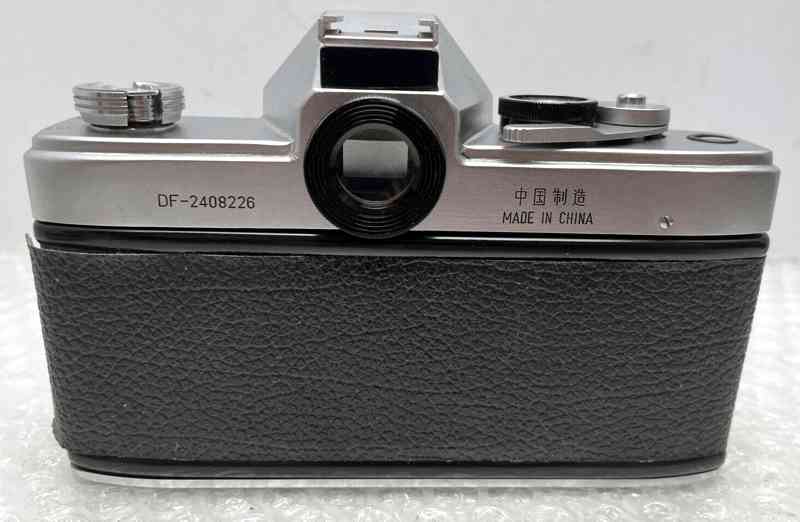
Everything else about the camera is the same.
It has shutter speeds for 1s to 1/1,000s, plus B, and a cold flash shoe.
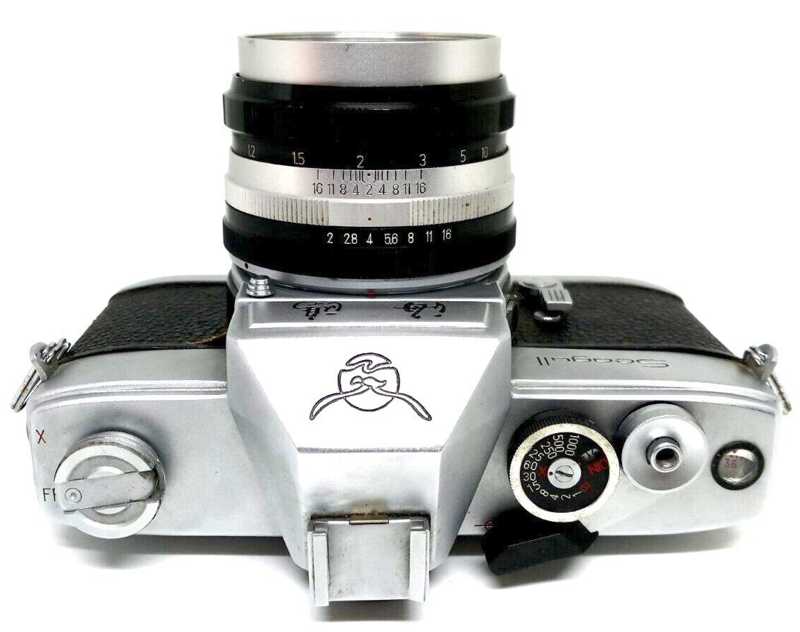
The dual flash connections -- X and FP -- are on the end of the camera under the film rewind lever.
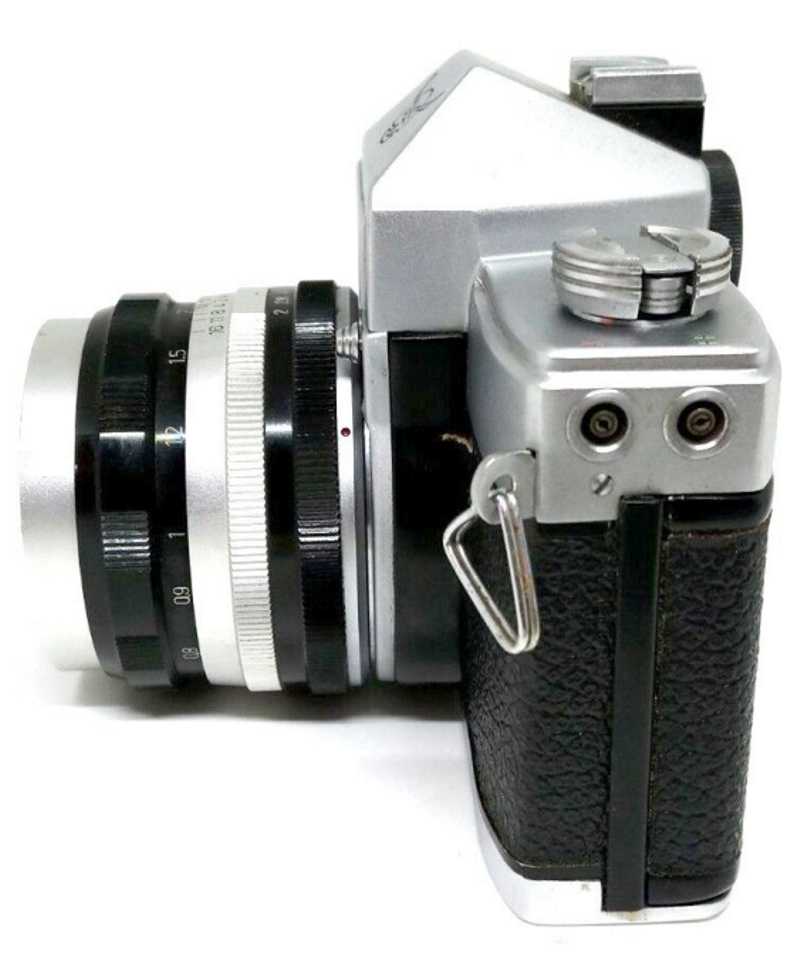
It retains the self-timer and the mirror lock-up feature -- which is useful if you happen to have a lens that needs it.
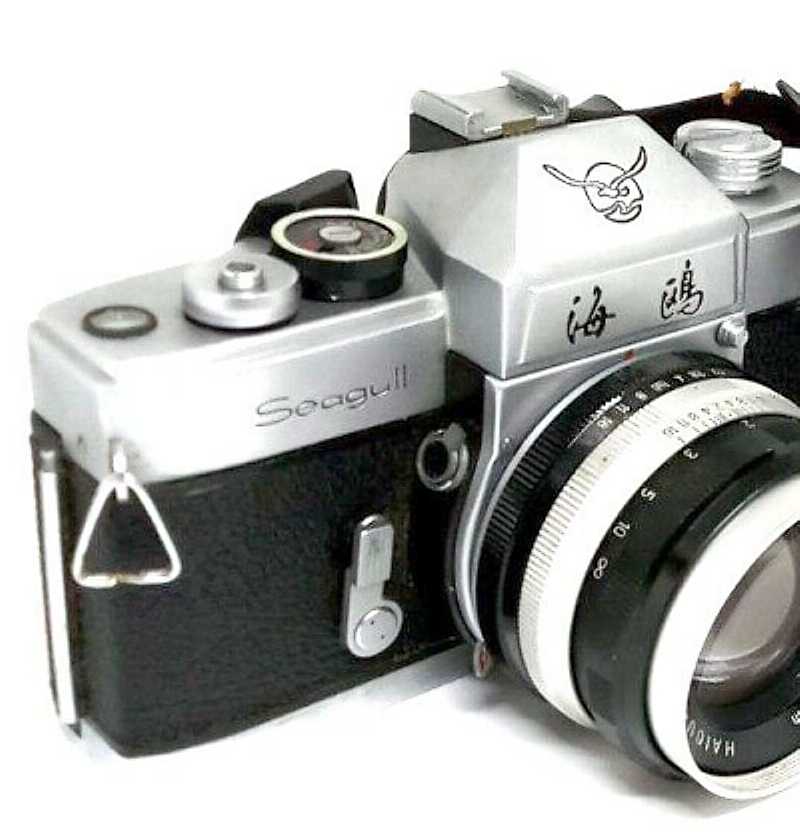
And it also keeps the motor-drive connections on the bottom, which of course were never used by Seagull or Minolta.
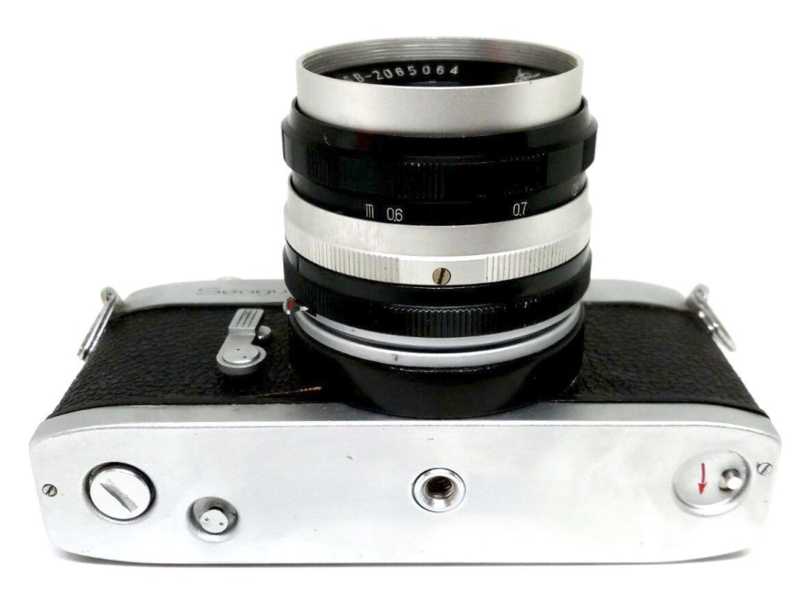
It is normally seen with a Haiou-64 58mm f2.0 lens -- which is basically a copy of the much-admired and sought-after Carl Zeiss Jena Biotar 58mm f2.0 from the 1920's -- for more information see: https://diediemustdive.wordpress.com/2019/08/10/the-chinese-biotar-haiou-64-??-58mm-f-2-sr/. These Seagull DF SLR cameras and lenses were intended mainly for the Chinese market -- and probably over 100,000 were made.
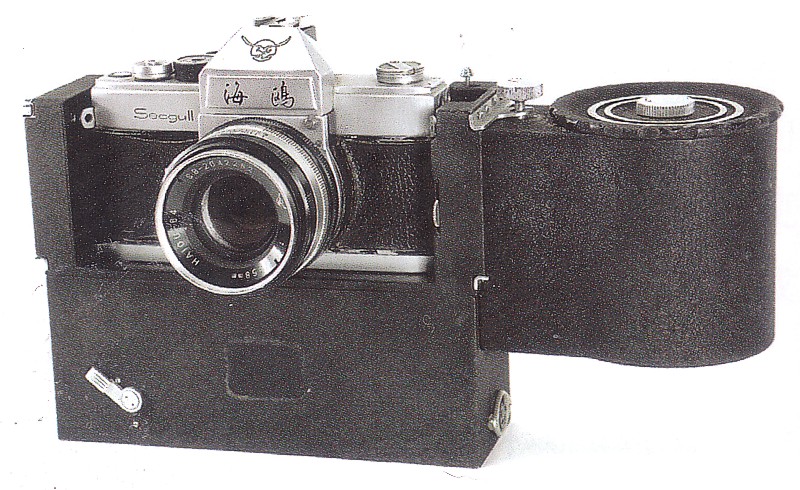
This model is the same camera as the Seagull (DF -- China model), above, but it adds a special back and bottom. As mentioned above, the Seagull DF maintained the motor drive capability of the Minolta SR-2 camera -- even though Minolta never used it. Consequently, Seagull had to develop their own motor drive unit. What it lacks in style, it makes up for in functionality. The film holder can supply up to 500 exposures, but the back has a film cutter built in -- and short lengths of film are created for immediate processing. The manual film advance can be used, and it retains the self-ftimer -- on the 24 volt DC motor & battery-pack. The combined unit weighs about NINE POUNDS!!! Who knows how many were made???
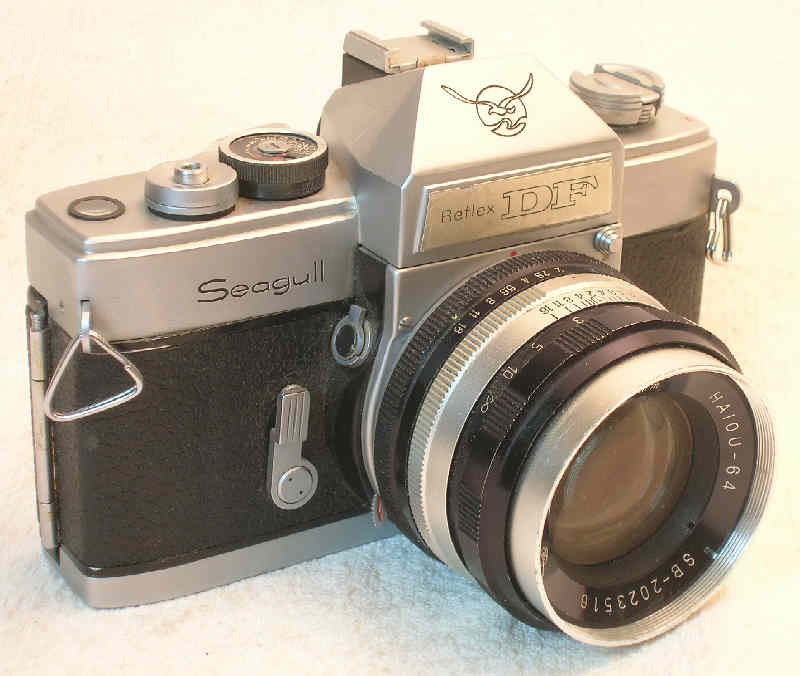
This model is the same camera as the Seagull (DF -- China model), above, but the exported model has a metallic decal glued over the Chinese characters -- which says "Reflex DF". It is normally seen with the same 58mm f2.0 lens, and probably several thousand were exported, and as with the domestic model it even retained the motor drive connections on the bottom.
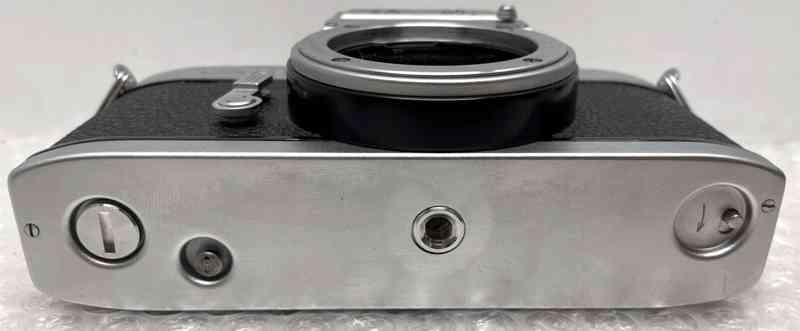
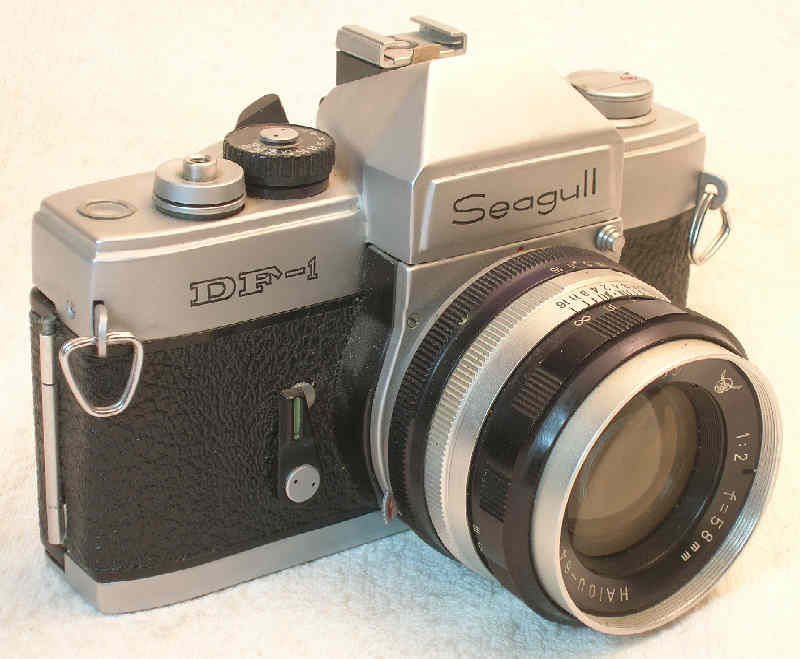
Somewhere in the early 1970s, Seagull came out with an updated version of the original DF. The most obvious changes are the movement of the Seagull name to the front nameplate directly above the lens and the Seagull icon is gone. Plus, the serial number no longer appears on the back, and "DF-1" now appears on the front under the film advance lever.
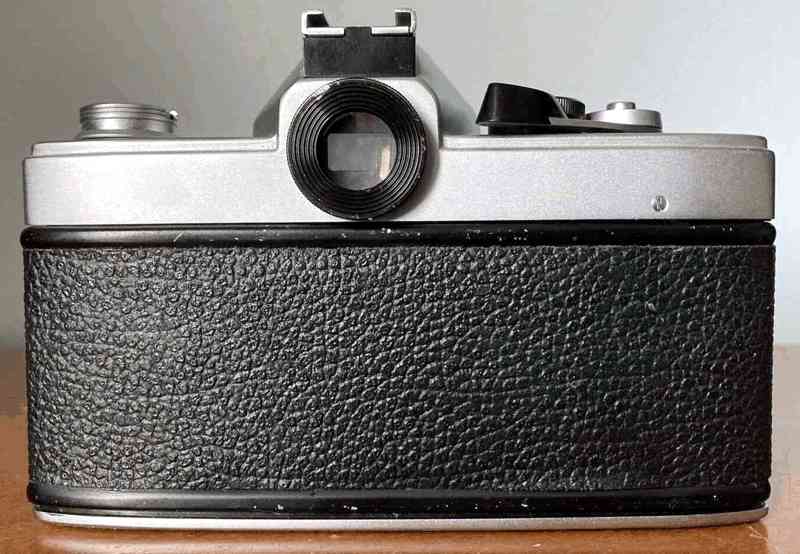
The main advantages of this model are a hot shoe, and a plastic tip on the film advance lever.
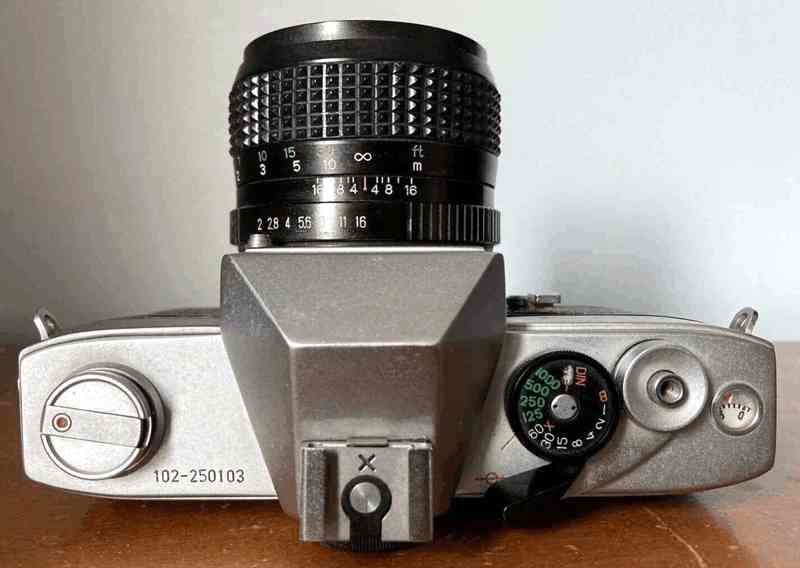
There were a few features removed from this model, as well. For example, the FP flash connection is gone, there is no longer a mirror lockup, and the motor drive connection on the bottom have been removed -- no big deal since neither Seagull nor Minolta ever produced a motor drive for these cameras.
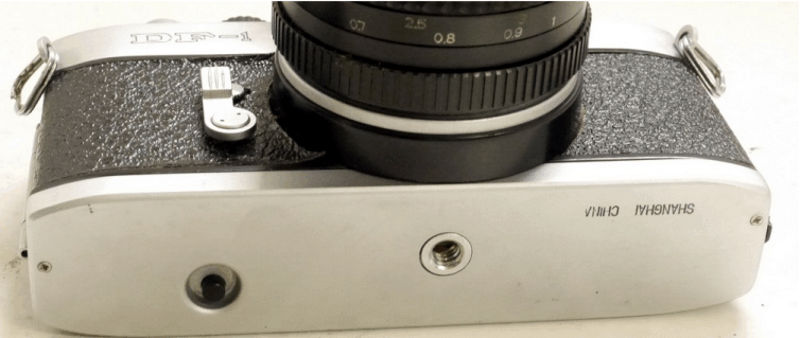
The focusing screen was improved, and it is just like the Minolta SRT102 -- which appeared a couple of years earlier (1973). More importantly, the film door opening is completely different -- compare photos above. On earlier DF models, the door is opened by sliding and pushing in a button on the bottom of the camera. This model of the DF adopts the more common method of raising the rewind knob. All of the other features of the DF-1 remained the same -- flash synch is at 1/40 with a special setting, cloth focal-plane shutter, cable release connection, tripod socket, self-timer (although the style of the self-timer lever was changed slightly).
But there were changes made to the DF-1 during its production -- so not all DF-1 cameras are identical. For example, the DF-1 can be found with two slightly different shutter speed dials -- and the only possible way to tell which version came first would be to compare serial numbers. One type has a tiny film speed window on the finely-milled shutter speed dial (left) -- which the earlier DF models and later DF-1ETM had -- while the other version has a coarser-knurled dial without the film reminder window (right).
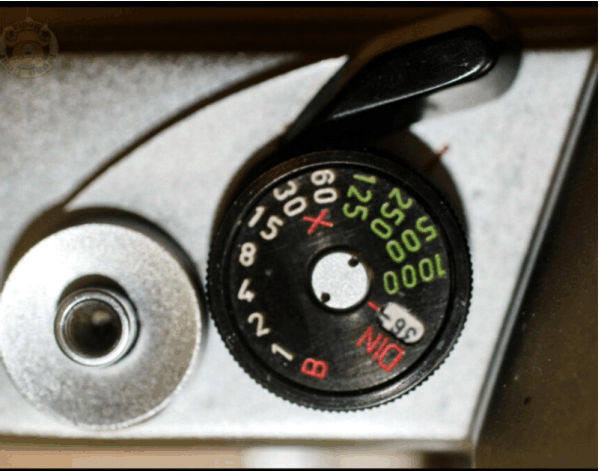
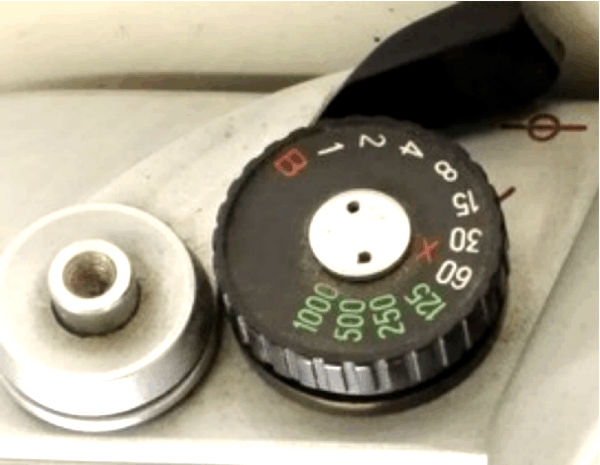
Another change is to the viewfinder cover. On the early DF-1 cameras, the viewfinder is round, but at some point, the viewfinder cover became rectangular. Another change is in the split-image rangefinder in the center of the viewing screen. It was initially horizontal, just as with the Minolta SRT102, but at some point, this was changed to a 45° angle. There were probably other differences made over time -- but probably not all at the same time.
The DF-1 is typically seen with the same 58mm f2.0 lens as the earlier models -- and in a chrome body, but it also came in a black body.
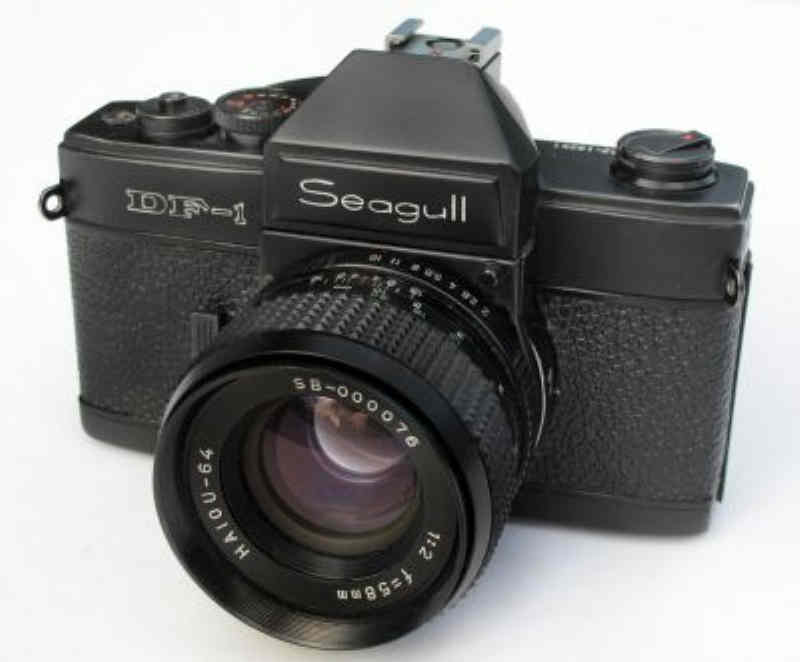
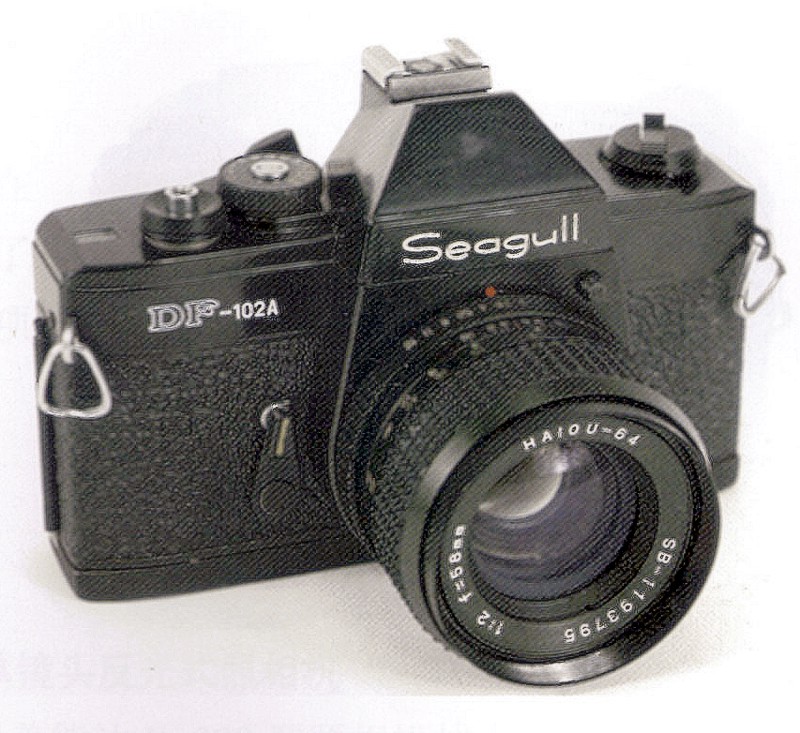
No, this camera does not have anything to do with the Minolta SRT102, as you might think. It is an intermediate
model between the DF-1 and the DF-2 in that, like the DF-2, it replaced the heavy metal top and bottom body plates
of the DF-1 with black plastic pieces. It also lacks a TTL meter, like the DF-1.:
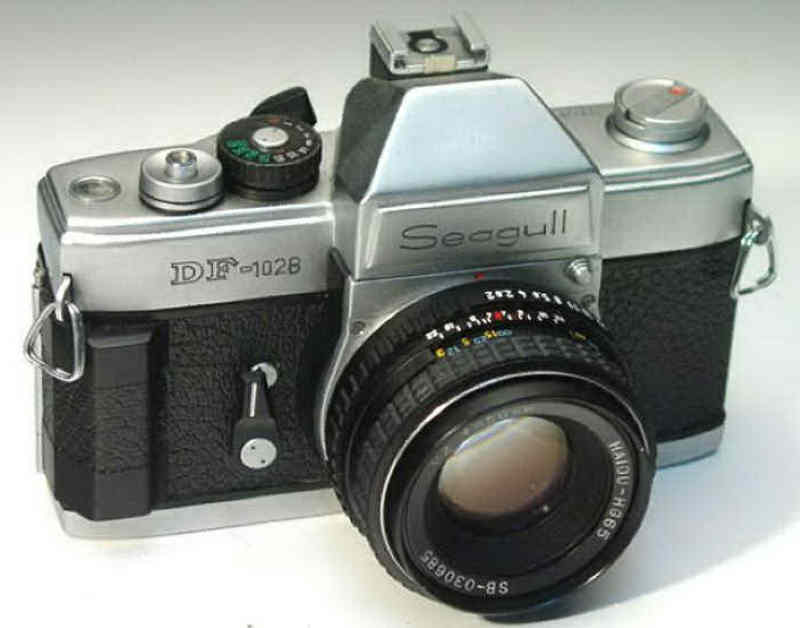
This camera is like the DF-102A, but unlike the DF-102A, it retains the metal top and bottom of the DF-1 --
and adds a small handgrip to the front:.
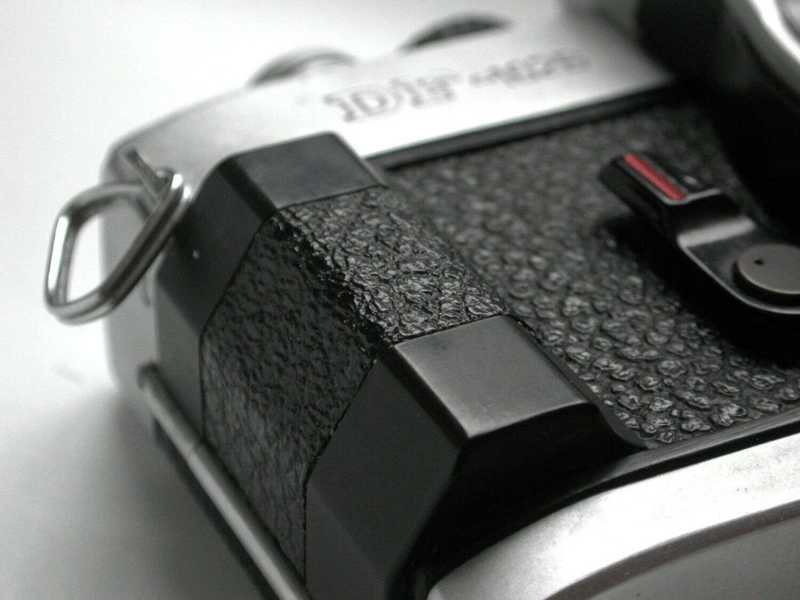
It retains the same shutter speed dial of the DF-1 with the "preferred" shutter speeds in green -- to
avoid picture blurring.
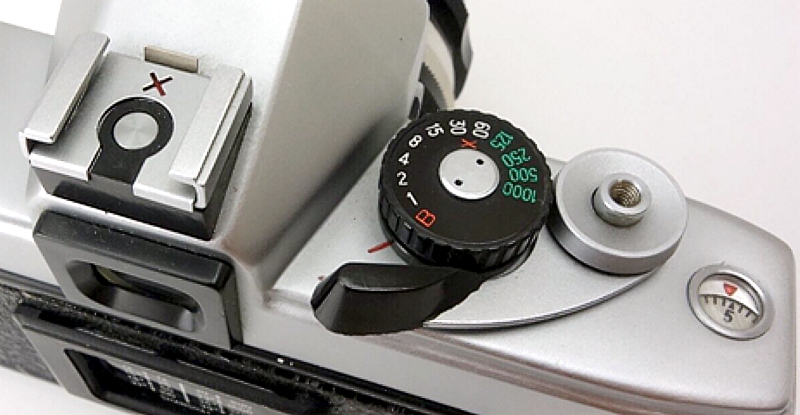
There's an "X" on the shutter speed dial for the X-synch, and the hot shoe is marked "X" to
indicate that it is X-synch ONLY:
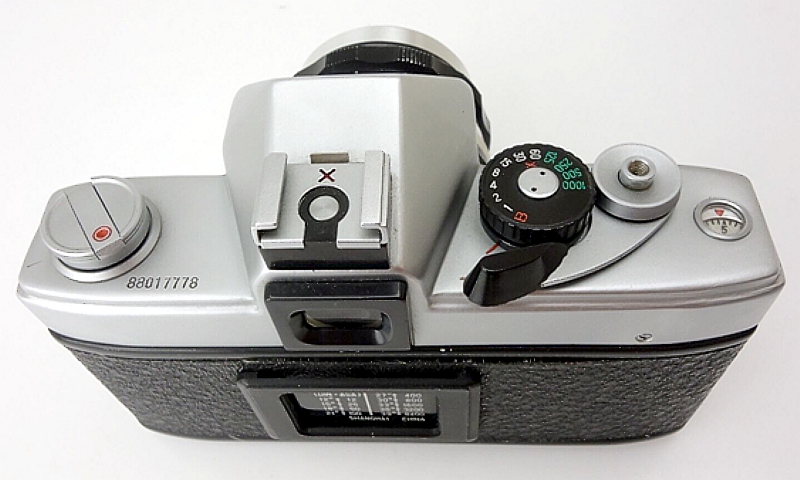
The FP connection on the earlier cameras has been removed from the end of the camera body:
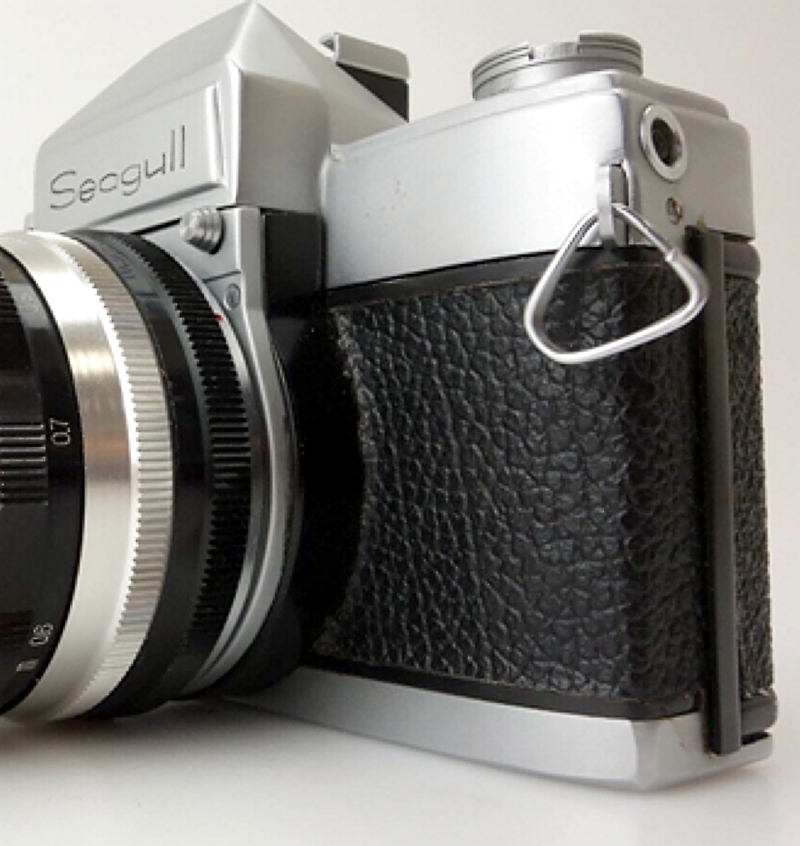
Also, on the DF-102b, the film reminder is moved from the shutter speed dial to the back of the camera:
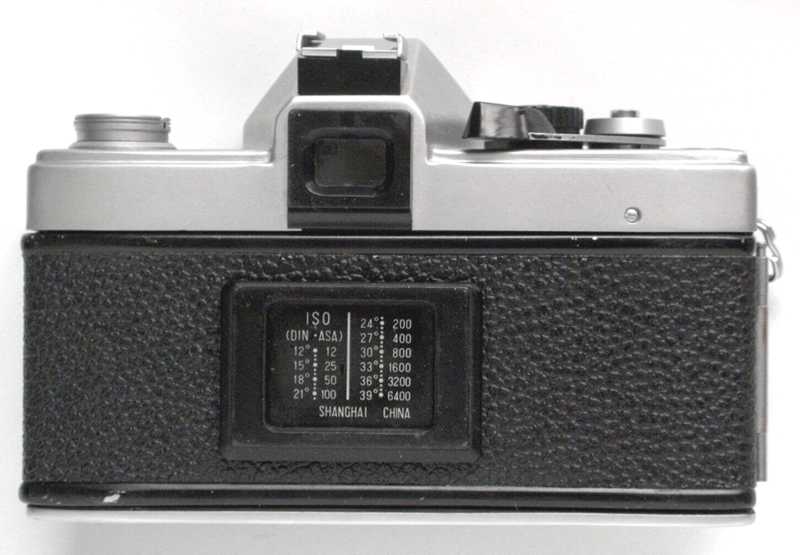
And it's not surprising that the motor drive connection -- that appeared in the original Seagull DF models -- has been removed.
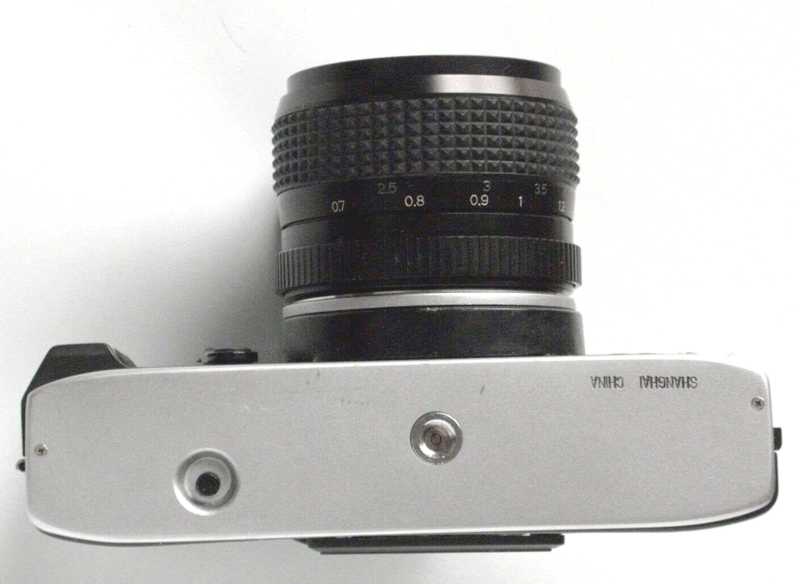
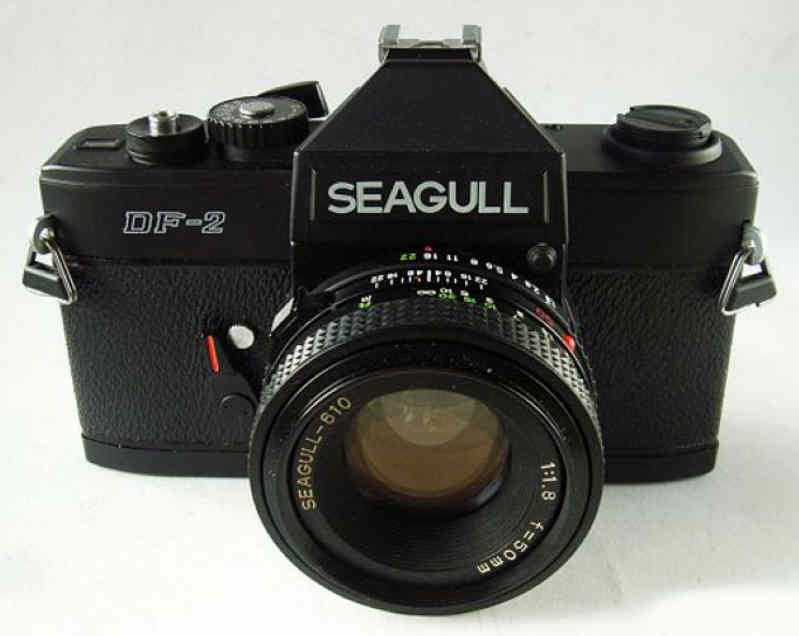
(1981) This camera is often listed as an updated version of the DF-1. Initially it was intended to include a TTL meter, but this feature was dropped from the production model. As a result, the DF-2 is basically the same camera as the DF-1 with a more stylish appearance, and more plastic parts. It weighs quite a bit less than the DF-1 as a result. The exterior of the body is now plastic, but good quality plastic. Even the leatherette is now plastic. Otherwise the features are the same as the DF-1, but it adds a film tab holder on the back -- and removes it from the shutter speed dial. The other change was the move from a round to a rectangular viewfinder.
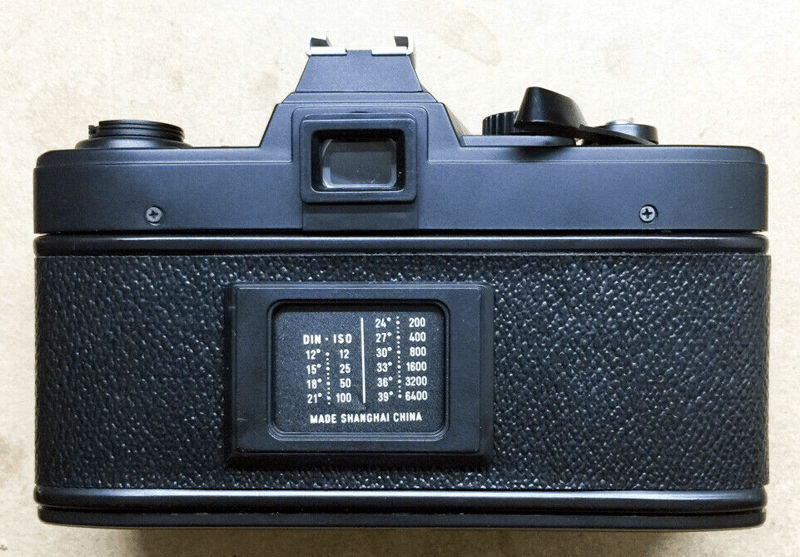
It still has a hot shoe, but no PC contact:
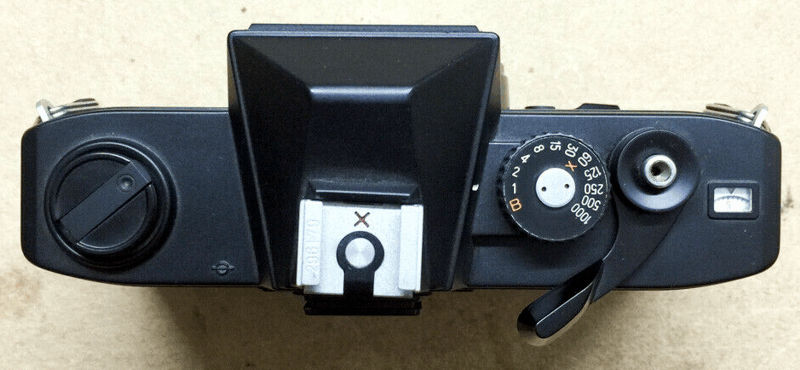
And, of course, there is no option for a motor drive:
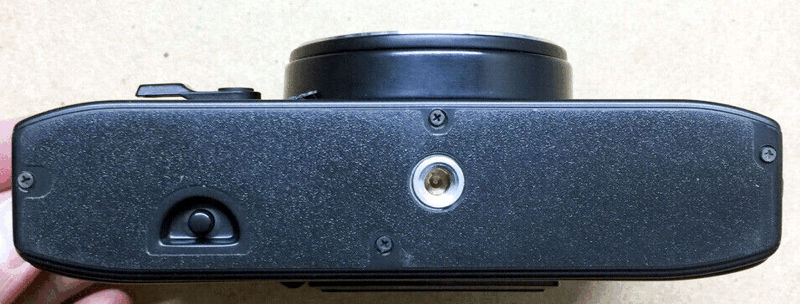
The DF-2 is normally it is seen with a 50mm f1.8 lens, instead of the 58mm. It is most commonly seen in black, but a chrome version was reportedly produced. It was also sold as the Zenit DF-2.
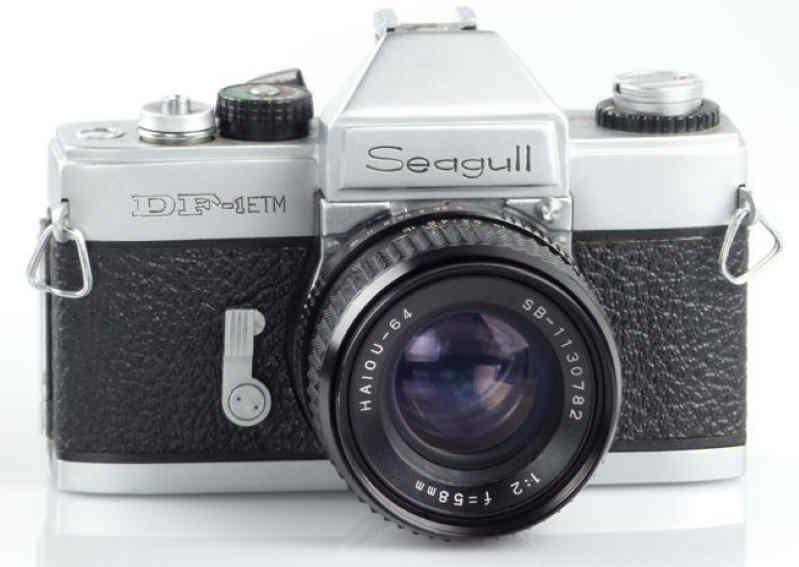
(1985) The DF-1ETM (perhaps Electronic Through the lens Meter?) is an improved version of the DF-1 -- by adding a built-in center-weighted meter. It is basically what the Seagull DF-2 was initially intended to be. Three LEDs in the lower right of the viewfinder indicate over-, under-, and correct exposure. Over-exposure is a RED "+"; under-exposure is a RED "-"; correct exposure is a GREEN dot -- by adjusting the shutter speed or the aperture. The ON/OFF switch turns the meter ON, but you have to lightly press the shutter release to display the LEDs -- then the LEDs stay ON until you turn the meter OFF. ISO settings from 25 to 1600. All of the other features are the same, except that it maintains the all-metal body of the DF-1. The "film reminder" window is back on the shutter speed dial, but this time it is there to set the film speed for the meter.
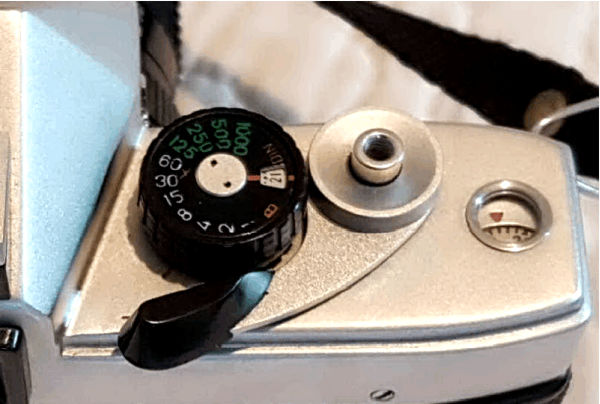
One unexpected "feature" of the camera is that the battery is inserted next to the viewfinder -- not on the bottom of the camera as you might expect -- and it used two A76 batteries, instead of a single 625 mercury cell!
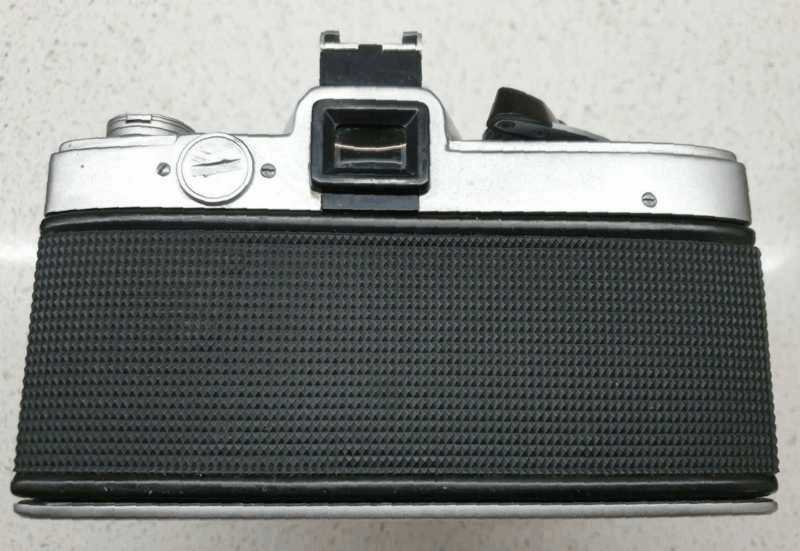
Due to it's TTL CdS photo cell, it has an ON/OFF switch which has been added to the bottom of the film rewind knob.
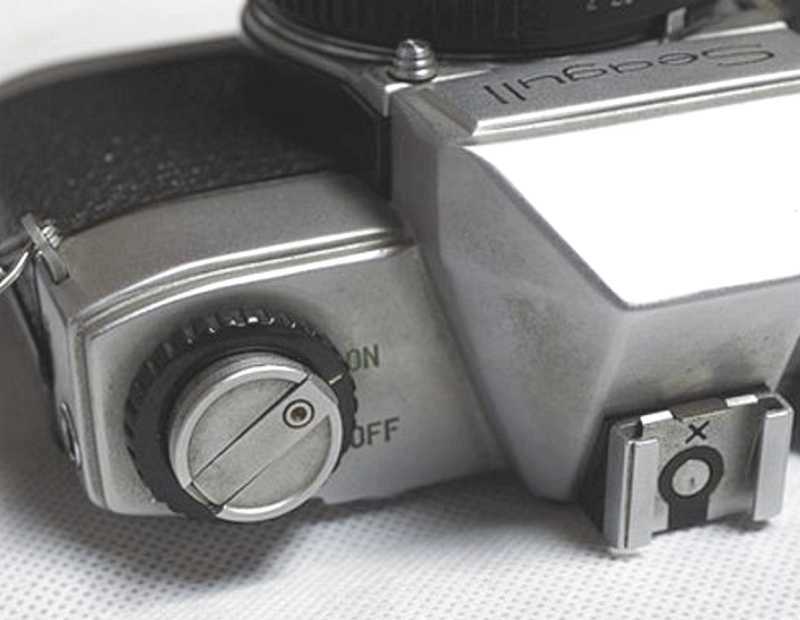
And, like the original DF-1, the DF-1ETM lacks any connection for a power winder.
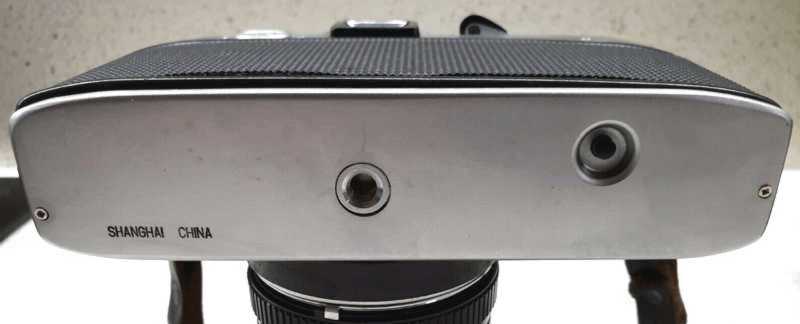
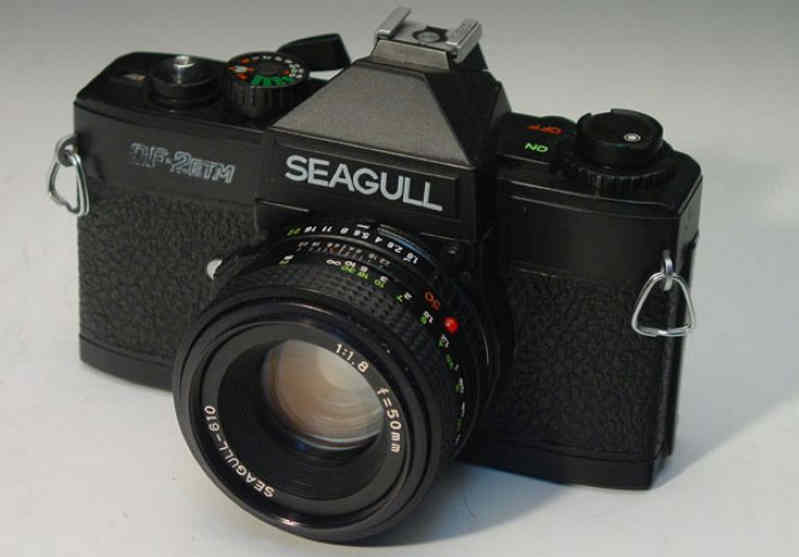
Around 1987 an improved version of the DF-2 appeared with a built-in center-weighted meter. All other features are the same. This and the DF-2 (above) were probably the only early (AKA, pre-Minolta) Seagull DF cameras that was sold under other names -- this one was also sold as the Zenit DF-2ETM in South America, and the Sakar SL-90MD.
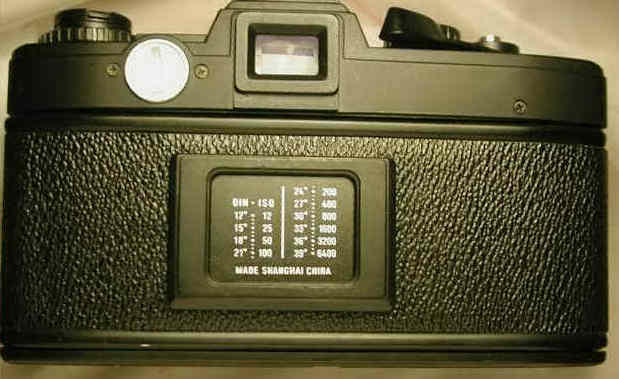
All three cameras use the same TTL metered-manual exposure method. Three LEDs in the lower right of the viewfinder indicate over-, under-, and correct exposure. Over-exposure is a RED "+"; under-exposure is a RED "-"; correct exposure is a GREEN dot -- by adjusting the shutter speed or the aperture. Pretty straight-forward. And all have the same straight-forward top with a straight-forward hot shoe -- no PC connection -- and an ON/OFF switch around the rewind knob for the meter (which uses TWO convenient A76 1.5v batteries).
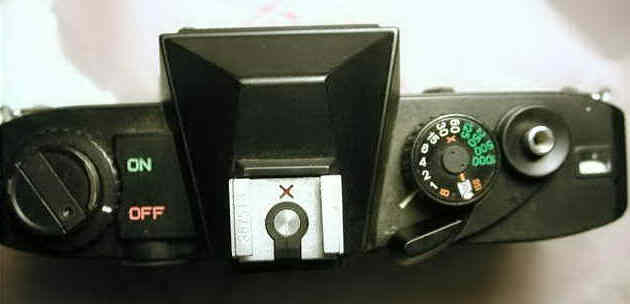
The shutter speed dial has an ISO speed setting window, and high speeds marked in GREEN.
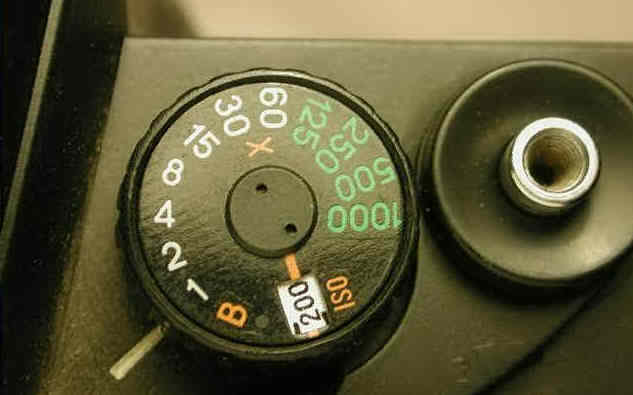
You would think that the green coloring indicates speeds above the synch speed, but the synch speed is actually a special setting between 1/30 and 1/60 -- 1/45.
Like its two brothers, the Seagull DF-2ETM did not accept a Motor Drive.
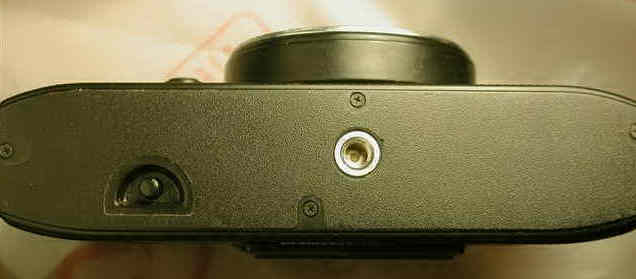
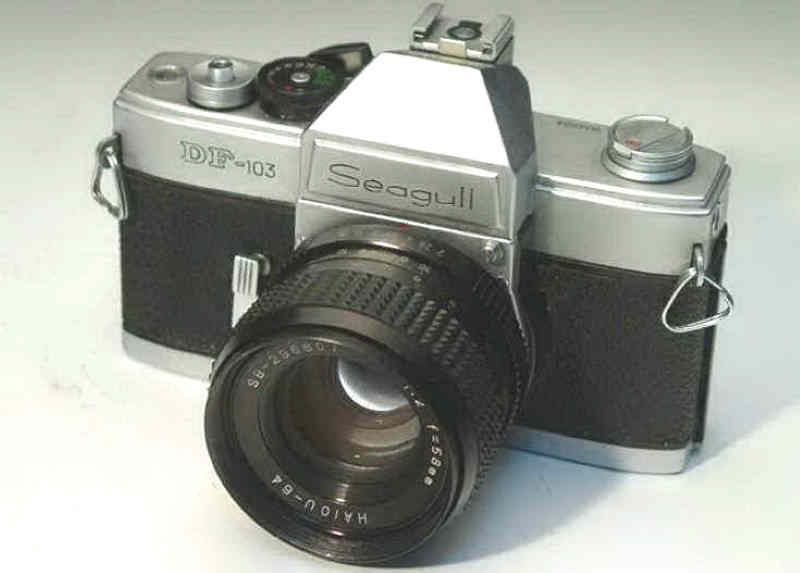
The DF-103 is a hard-to-find version of the DF-1, and it has been suggested that it is an "orphan" version of the DF series -- orphan in the sense that it was produced to use up left over parts from the original DF model production. Whether or not this is partially or totally true is less important than the DF-103 being a simpler version of the DF-1. The main difference is that the top shutter speed is reduced to 1/500 -- similar to the Minolta SR-2 vs SR-1 which had the same difference. (And as with the two Minolta models, there is no difference in weight between the DF-1 and DF-103.) Apparently achieving a 1/1,000 shutter speed is expensive -- that's why Minolta dropped it on the SR-1, and it decreased the price of the otherwise comparable SR-2 dramatically. On the DF-103, there is a notch on the shutter speed dial for the 1/1,000 speed, but it is not marked. The shutter does fire when set to the unmarked 1/1,000s "space", but the shutter speed probably remains at 1/500s.
And similar to several of the other early DF cameras, the high shutter speeds on the DF-103 are marked in GREEN and the synch speed is 1/45s -- a separate setting between 1/30 and 1/60. I suppose that the GREEN shutter speeds are simply recommended shutter speeds -- to avoid blurred pictures.
Like the DF-1, each DF-103 camera can vary with minor differences. This does suggest that the supply of parts may have played a part. It is often seen with the HAIOU-HG65 50mm f2.0, instead of the older, but more common, larger and heavier, HAIOU-64 58mm f2.
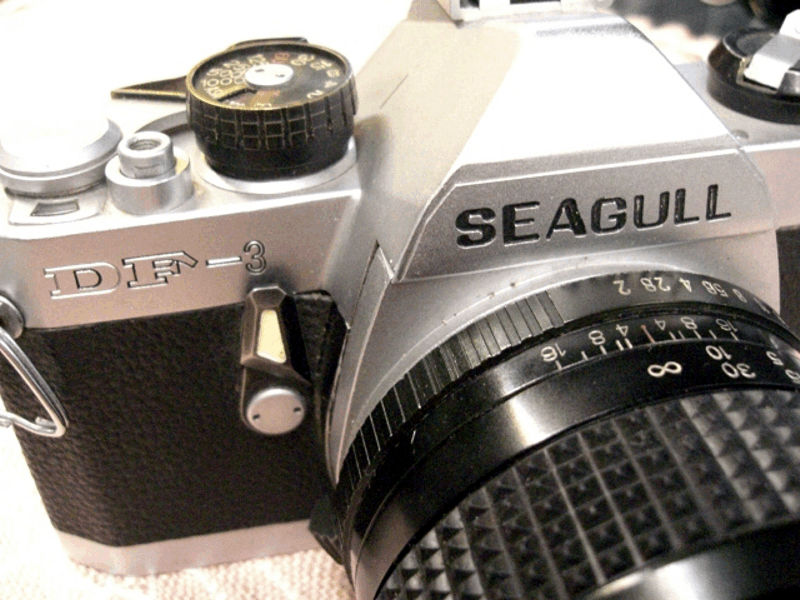
Apparently, there actually was a Seagull DF-3, but you are unlikely to find one. The few pictures of this camera show that it had a separate shutter release button and film advance lever -- unlike the DF-1, DF-2, and other early models. It can also be distinguished because of its unusually placed self-timer -- placed much higher on the camera body. Seagull apparently designed a DF-3, and made some, but they may have only been prototypes. We will probably never know for sure. In any event, it was designed to use Pentax K lenses (see picture), and not Minolta lenses.